2015年6月大学英语六级考试真题及答案(共三套)
- 格式:docx
- 大小:80.96 KB
- 文档页数:12
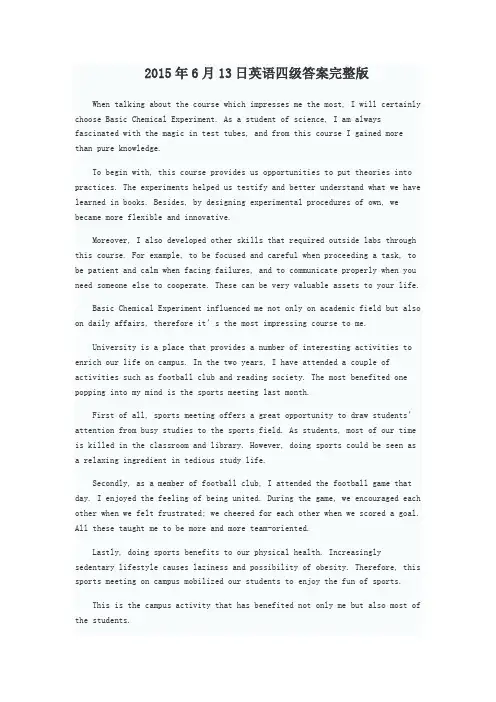
2015年6月13日英语四级答案完整版When talking about the course which impresses me the most, I will certainly choose Basic Chemical Experiment. As a student of science, I am always fascinated with the magic in test tubes, and from this course I gained more than pure knowledge.To begin with, this course provides us opportunities to put theories into practices. The experiments helped us testify and better understand what we have learned in books. Besides, by designing experimental procedures of own, we became more flexible and innovative.Moreover, I also developed other skills that required outside labs through this course. For example, to be focused and careful when proceeding a task, to be patient and calm when facing failures, and to communicate properly when you need someone else to cooperate. These can be very valuable assets to your life.Basic Chemical Experiment influenced me not only on academic field but also on daily affairs, therefore it’s the most impressing course to me.University is a place that provides a number of interesting activities to enrich our life on campus. In the two years, I have attended a couple of activities such as football club and reading society. The most benefited one popping into my mind is the sports meeting last month.First of all, sports meeting offers a great opportunity to draw students’attention from busy studies to the sports field. As students, most of our time is killed in the classroom and library. However, doing sports could be seen as a relaxing ingredient in tedious study life.Secondly, as a member of football club, I attended the football game that day. I enjoyed the feeling of being united. During the game, we encouraged each other when we felt frustrated; we cheered for each other when we scored a goal. All these taught me to be more and more team-oriented.Lastly, doing sports benefits to our physical health. Increasingly sedentary lifestyle causes laziness and possibility of obesity. Therefore, this sports meeting on campus mobilized our students to enjoy the fun of sports.This is the campus activity that has benefited not only me but also most of the students.Rose is my roommate, classmate and my best friend in my college. She has a round face and a little plump. One can always find a nice smile on her face, which reflects her amiable and pleasant character. Our friendship attributes to her great influence on me.In terms of study, she is good at English, while English is not my cup of tea. When I am confused about teacher’s explanation of texts, she always interprets them to me in an explicit way. I really appreciate her help. Besides, she also imparts me a few language learning tips and recommendations which arouse my learning interest.In addition, in the leisure time, she helps me a lot as well. Because I am not the local student and my hometown is far away from here, sometimes I feel homesick. However, I always have Rose on my side. Her accompany gives me great comfort.I feel so lucky that I could have such a good friend, who teaches me and help me in my study and leisure life, so she is the classmate that has influenced me most in college.四级听力答案:短对话1.B He has not cleared the apartment since his mother’s visit.2.C They might as well take the next bus.3.C She has to do extra work for a few days.4.A change her job.5.D He failed to do what he promised to do.6.B The woman does not like horror films.7.C The speakers share a common view on love.8.A Preparations for a forum.四级听力答案:长对话9. B Scandinavia10. D More women will work outside the family11. D Spend more time changing women’s attitudes.12. A In a restaurant13. C He is the Managing Director of Jayal Motors14. B To get a good import agent15. D His determination四级听力答案与点评:短文第一篇16. What are scientists trying to explain according to the passage?答案:(A) How being an identical twin influences one’s identify.【点评】:细节题。
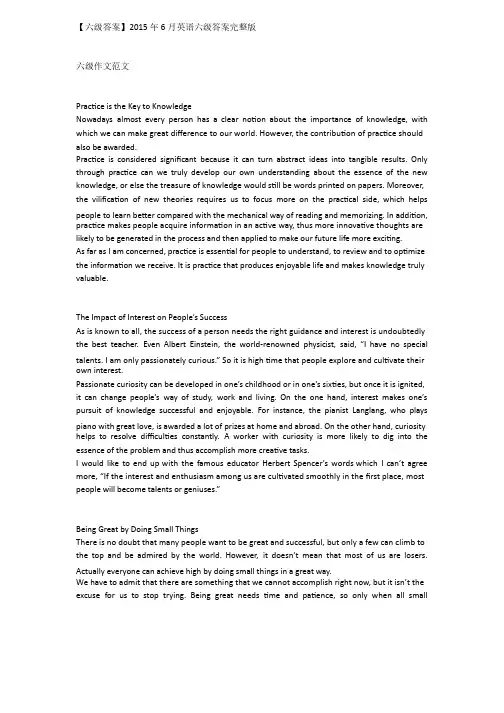
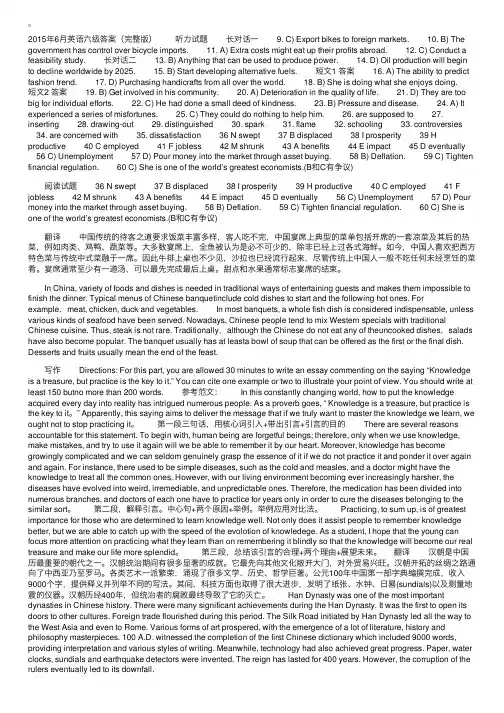
2015年6⽉英语六级答案(完整版) 听⼒试题 长对话⼀ 9. C) Export bikes to foreign markets. 10. B) The government has control over bicycle imports. 11. A) Extra costs might eat up their profits abroad. 12. C) Conduct a feasibility study. 长对话⼆ 13. B) Anything that can be used to produce power. 14. D) Oil production will begin to decline worldwide by 2025. 15. B) Start developing alternative fuels. 短⽂1 答案 16. A) The ability to predict fashion trend. 17. D) Purchasing handicrafts from all over the world. 18. B) She is doing what she enjoys doing. 短⽂2 答案 19. B) Get involved in his community. 20. A) Deterioration in the quality of life. 21. D) They are too big for individual efforts. 22. C) He had done a small deed of kindness. 23. B) Pressure and disease. 24. A) It experienced a series of misfortunes. 25. C) They could do nothing to help him. 26. are supposed to 27. inserting 28. drawing-out 29. distinguished 30. spark 31. flame 32. schooling 33. controversies 34. are concerned with 35. dissatisfaction 36 N swept 37 B displaced 38 I prosperity 39 H productive 40 C employed 41 F jobless 42 M shrunk 43 A benefits 44 E impact 45 D eventually 56 C) Unemployment 57 D) Pour money into the market through asset buying. 58 B) Deflation. 59 C) Tighten financial regulation. 60 C) She is one of the world’s greatest economists.(B和C有争议) 阅读试题 36 N swept 37 B displaced 38 I prosperity 39 H productive 40 C employed 41 F jobless 42 M shrunk 43 A benefits 44 E impact 45 D eventually 56 C) Unemployment 57 D) Pour money into the market through asset buying. 58 B) Deflation. 59 C) Tighten financial regulation. 60 C) She is one of the world’s greatest economists.(B和C有争议) 翻译 中国传统的待客之道要求饭菜丰富多样,客⼈吃不完,中国宴席上典型的菜单包括开席的⼀套凉菜及其后的热菜,例如⾁类、鸡鸭、蔬菜等。
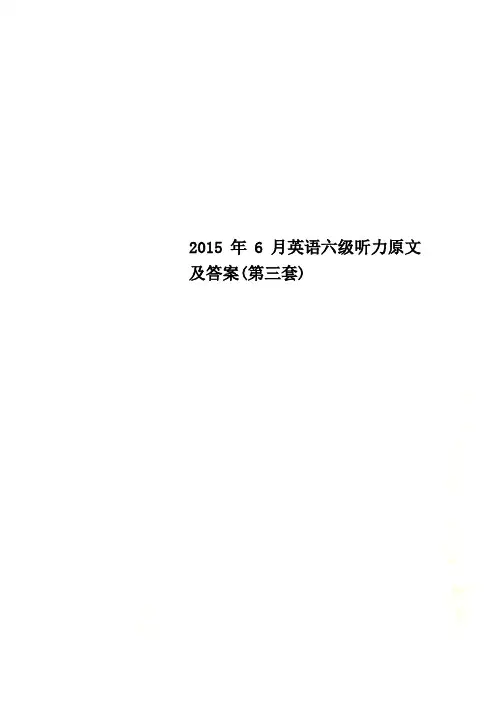
2015年6月英语六级听力原文及答案(第三套)1.M: Good news! I am not going to have surgery after all. The doctor says I can start working out again soon and maybe play football like before in a few weeks.W.. That's terrific. It will be eat if you could get back in shape in time for the World Cups.O: What do we learn from the conversation?A)【精析】综合理解题。
男士告诉女士自己不用做手术了,几周后有可能就可以像以前那样踢足球了;女士回答说,如果男士能在举行世界杯时恢复健康就好了。
可见男士有可能参加世界杯比赛。
terrific在口语中指“很好,太棒了”;in shape意为“处于良好状态”。
2. M: I really need to make some extra money. You know, I've practically spent my entire budget for this semester. W: Why_not check out the new cafeteria at Market Street? I think there are still a few opening suitable for seniors like LCou.Q: What does the woman suggest the man do?D.【精析】请求建议题。
男士表示他这个学期的预算已经用光了,需要去赚钱;女士使用Why not…句式建议男士去市场街的新餐厅A)误;男士回答他已接到好几个反映此问题的电话了.估计是计算机系统出了毛病,并表示错误会在几个小时内得到纠正。
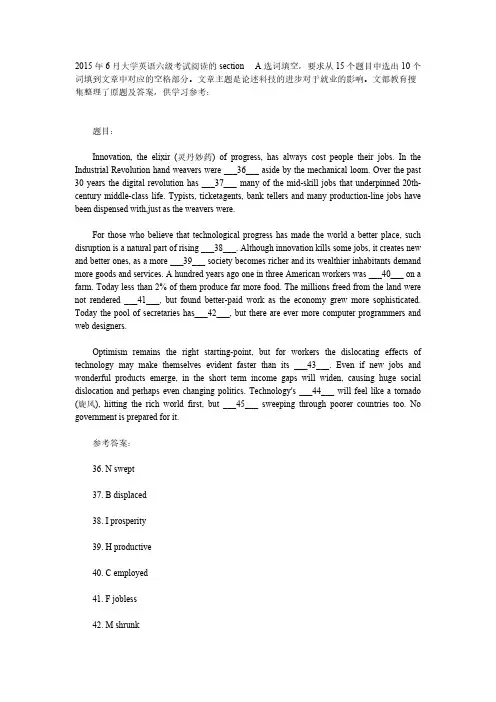
2015年6月大学英语六级考试阅读的section A选词填空,要求从15个题目中选出10个词填到文章中对应的空格部分。
文章主题是论述科技的进步对于就业的影响。
文都教育搜集整理了原题及答案,供学习参考: 题目: Innovation, the elixir (灵丹妙药) of progress, has always cost people their jobs. In the Industrial Revolution hand weavers were ___36___ aside by the mechanical loom. Over the past 30 years the digital revolution has ___37___ many of the mid-skill jobs that underpinned 20th-century middle-class life. Typists, ticketagents, bank tellers and many production-line jobs have been dispensed with,just as the weavers were. For those who believe that technological progress has made the world a better place, such disruption is a natural part of rising ___38___. Although innovation kills some jobs, it creates new and better ones, as a more ___39___ society becomes richer and its wealthier inhabitants demand more goods and services. A hundred years ago one in three American workers was ___40___ on a farm. Today less than 2% of them produce far more food. The millions freed from the land were not rendered ___41___, but found better-paid work as the economy grew more sophisticated. Today the pool of secretaries has___42___, but there are ever more computer programmers and web designers. Optimism remains the right starting-point, but for workers the dislocating effects of technology may make themselves evident faster than its ___43___. Even if new jobs and wonderful products emerge, in the short term income gaps will widen, causing huge social dislocation and perhaps even changing politics. Technology's ___44___ will feel like a tornado (旋风), hitting the rich world first, but ___45___ sweeping through poorer countries too. No government is prepared for it. 参考答案: 36. N swept 37. B displaced 38. I prosperity 39. H productive 40. C employed 41. F jobless 42. M shrunk 43. A benefits 44. E impact 45. D eventuallyPassage Two Questions 61-65 are based on the following passage. Some of the world’s most significant problems never hit headlines.One example comes from agriculture. Food riots and hunger make news. But the trend lying behind these matters is rarely talked about. This is the decline in the growth in yields of some of the world’s major crops.A new study by the University of Minnesota and McGill University in Montreal looks at where, and how far, this decline is occurring. The authors take a vast number of data points for the four most important crops: rice, wheat corn and soybeans(大豆). They find that on between 24% and 39% of all harvested areas, the improvement in yields that tood place before the 1980s slowed down in the 1990s and 2000s. There are two worrying features of the slowdown. One is that it has been particularly sharp in the world’s most populous(人口多的) countries, India and China. Their ability to feed themselves has been an important source of relative stability both within the countries and on world food markets. That self-sufficiency cannot be taken for granted if yields continue to slow down or reverse. Second, yield growth has been lower in wheat and rice than in corn and soyabeans. This is problematic because wheat and rice are more important as foods, accounting for around half of all calories consumed. Corn and soyabeans are more important as feed grains. The authors note that “we have preferentially focused our crop improvement efforts on feeding animals and cars rather than on crops that feed people and are the basis of food security in much of the world.” The report qualifies the more optimistic findings of another new paper which suggests that the world will not have to dig up a lot more land for farming in order to feed 9 billion people in 2050, as the Food and Agriculture Organisation has argued. Instead, it says, thanks to slowing population growth, land currently ploughted up for crops might be able to revert(回返)to forest or wilderness. This could happen. The trouble is that the forecast assumes continued improvements in yields, which may not actually happen. 注意:此部分试题请在答题卡2上作答。
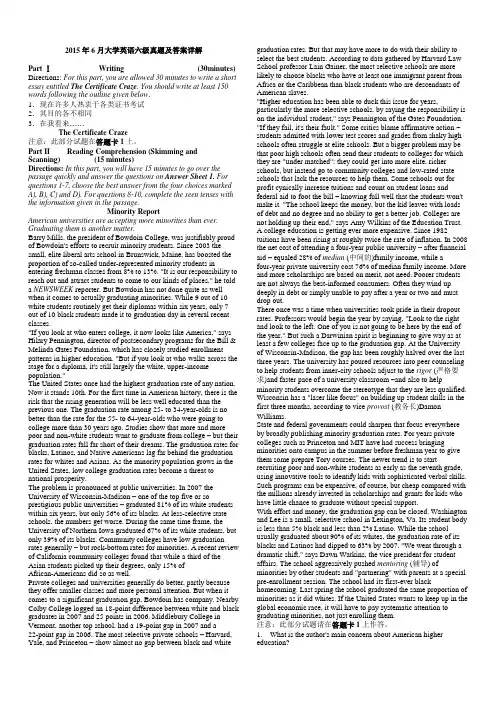
2015年6月大学英语六级真题及答案详解Part ⅠWriting (30minutes) Directions: For this part, you are allowed 30 minutes to write a short essay entitled The Certificate Craze. You should write at least 150 words following the outline given below.1.现在许多人热衷于各类证书考试2.其目的各不相同3.在我看来……The Certificate Craze注意:此部分试题在答题卡1上。
Part II Reading Comprehension (Skimming and Scanning) (15 minutes)Directions:In this part, you will have 15 minutes to go over the passage quickly and answer the questions on Answer Sheet 1. For questions 1-7, choose the best answer from the four choices marked A), B), C) and D). For questions 8-10, complete the seen tenses with the information given in the passage.Minority ReportAmerican universities are accepting more minorities than ever. Graduating them is another matter.Barry Mills, the president of Bowdoin College, was justifiably proud of Bowdoin's efforts to recruit minority students. Since 2003 the small, elite liberal arts school in Brunswick, Maine, has boosted the proportion of so-called under-represented minority students in entering freshman classes from 8% to 13%. "It is our responsibility to reach out and attract students to come to our kinds of places," he told a NEWSWEEK reporter. But Bowdoin has not done quite as well when it comes to actually graduating minorities. While 9 out of 10 white students routinely get their diplomas within six years, only 7 out of 10 black students made it to graduation day in several recent classes."If you look at who enters college, it now looks like America," says Hilary Pennington, director of postsecondary programs for the Bill & Melinda Gates Foundation, which has closely studied enrollment patterns in higher education. "But if you look at who walks across the stage for a diploma, it's still largely the white, upper-income population."The United States once had the highest graduation rate of any nation. Now it stands 10th. For the first time in American history, there is the risk that the rising generation will be less well educated than the previous one. The graduation rate among 25- to 34-year-olds is no better than the rate for the 55- to 64-year-olds who were going to college more than 30 years ago. Studies show that more and more poor and non-white students want to graduate from college – but their graduation rates fall far short of their dreams. The graduation rates for blacks, Latinos, and Native Americans lag far behind the graduation rates for whites and Asians. As the minority population grows in the United States, low college graduation rates become a threat to national prosperity.The problem is pronounced at public universities. In 2007 the University of Wisconsin-Madison – one of the top five or so prestigious public universities – graduated 81% of its white students within six years, but only 56% of its blacks. At less-selective state schools, the numbers get worse. During the same time frame, the University of Northern Iowa graduated 67% of its white students, but only 39% of its blacks. Community colleges have low graduation rates generally – but rock-bottom rates for minorities. A recent review of California community colleges found that while a third of the Asian students picked up their degrees, only 15% ofAfrican-Americans did so as well.Private colleges and universities generally do better, partly because they offer smaller classes and more personal attention. But when it comes to a significant graduation gap, Bowdoin has company. Nearby Colby College logged an 18-point difference between white and black graduates in 2007 and 25 points in 2006. Middlebury College in Vermont, another top school, had a 19-point gap in 2007 and a22-point gap in 2006. The most selective private schools – Harvard, Yale, and Princeton – show almost no gap between black and white graduation rates. But that may have more to do with their ability to select the best students. According to data gathered by Harvard Law School professor Lain Gainer, the most selective schools are more likely to choose blacks who have at least one immigrant parent from Africa or the Caribbean than black students who are descendants of American slaves."Higher education has been able to duck this issue for years, particularly the more selective schools, by saying the responsibility is on the individual student," says Pennington of the Gates Foundation. "If they fail, it's their fault." Some critics blame affirmative action –students admitted with lower test scores and grades from shaky high schools often struggle at elite schools. But a bigger problem may be that poor high schools often send their students to colleges for which they are "under matched": they could get into more elite, richer schools, but instead go to community colleges and low-rated state schools that lack the resources to help them. Some schools out for profit cynically increase tuitions and count on student loans and federal aid to foot the bill – knowing full well that the students won't make it. "The school keeps the money, but the kid leaves with loads of debt and no degree and no ability to get a better job. Colleges are not holding up their end," says Amy Wilkins of the Education Trust.A college education is getting ever more expensive. Since 1982 tuitions have been rising at roughly twice the rate of inflation. In 2008 the net cost of attending a four-year public university – after financial aid – equaled 28% of median (中间的)family income, while afour-year private university cost 76% of median family income. More and more scholarships are based on merit, not need. Poorer students are not always the best-informed consumers. Often they wind up deeply in debt or simply unable to pay after a year or two and must drop out.There once was a time when universities took pride in their dropout rates. Professors would begin the year by saying, "Look to the right and look to the left. One of you is not going to be here by the end of the year." But such a Darwinian spirit is beginning to give way as at least a few colleges face up to the graduation gap. At the University of Wisconsin-Madison, the gap has been roughly halved over the last three years. The university has poured resources into peer counseling to help students from inner-city schools adjust to the rigor (严格要求)and faster pace of a university classroom –and also to help minority students overcome the stereotype that they are less qualified. Wisconsin has a "laser like focus" on building up student skills in the first three months, according to vice provost (教务长)Damon Williams.State and federal governments could sharpen that focus everywhere by broadly publishing minority graduation rates. For years private colleges such as Princeton and MIT have had success bringing minorities onto campus in the summer before freshman year to give them some prepare Tory courses. The newer trend is to start recruiting poor and non-white students as early as the seventh grade, using innovative tools to identify kids with sophisticated verbal skills. Such programs can be expensive, of course, but cheap compared with the millions already invested in scholarships and grants for kids who have little chance to graduate without special support.With effort and money, the graduation gap can be closed. Washington and Lee is a small, selective school in Lexington, Va. Its student body is less than 5% black and less than 2% Latino. While the school usually graduated about 90% of its whites, the graduation rate of its blacks and Latinos had dipped to 63% by 2007. "We went through a dramatic shift," says Dawn Watkins, the vice president for student affairs. The school aggressively pushed mentoring (辅导) of minorities by other students and "partnering" with parents at a special pre-enrollment session. The school had its first-ever black homecoming. Last spring the school graduated the same proportion of minorities as it did whites. If the United States wants to keep up in the global economic race, it will have to pay systematic attention to graduating minorities, not just enrolling them.注意:此部分试题请在答题卡1上作答。
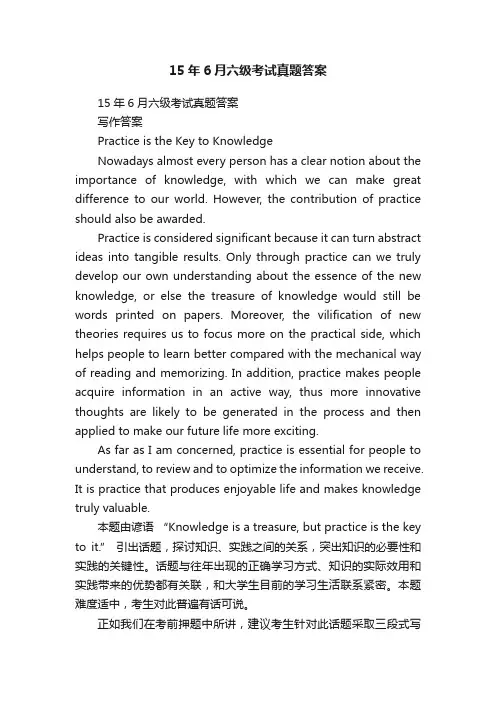
15年6月六级考试真题答案15年6月六级考试真题答案写作答案Practice is the Key to KnowledgeNowadays almost every person has a clear notion about the importance of knowledge, with which we can make great difference to our world. However, the contribution of practice should also be awarded.Practice is considered significant because it can turn abstract ideas into tangible results. Only through practice can we truly develop our own understanding about the essence of the new knowledge, or else the treasure of knowledge would still be words printed on papers. Moreover, the vilification of new theories requires us to focus more on the practical side, which helps people to learn better compared with the mechanical way of reading and memorizing. In addition, practice makes people acquire information in an active way, thus more innovative thoughts are likely to be generated in the process and then applied to make our future life more exciting.As far as I am concerned, practice is essential for people to understand, to review and to optimize the information we receive. It is practice that produces enjoyable life and makes knowledge truly valuable.本题由谚语“Knowledge is a treasure, but practice is the key to it.” 引出话题,探讨知识、实践之间的关系,突出知识的必要性和实践的关键性。
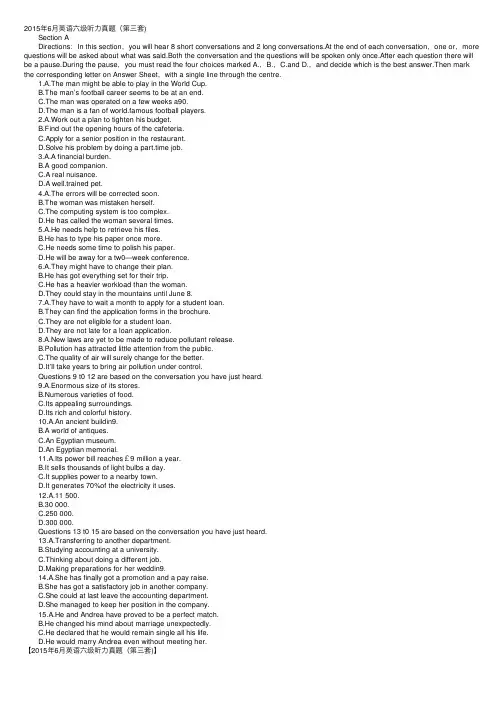
2015年6⽉英语六级听⼒真题(第三套) Section A Directions:In this section,you will hear 8 short conversations and 2 long conversations.At the end of each conversation,one or,more questions will be asked about what was said.Both the conversation and the questions will be spoken only once.After each question there will be a pause.During the pause,you must read the four choices marked A.,B.,C.and D.,and decide which is the best answer.Then mark the corresponding letter on Answer Sheet,with a single line through the centre. 1.A.The man might be able to play in the World Cup. B.The man’s football career seems to be at an end. C.The man was operated on a few weeks a90. D.The man is a fan of world.famous football players. 2.A.Work out a plan to tighten his budget. B.Find out the opening hours of the cafeteria. C.Apply for a senior position in the restaurant. D.Solve his problem by doing a part.time job. 3.A.A financial burden. B.A good companion. C.A real nuisance. D.A well.trained pet. 4.A.The errors will be corrected soon. B.The woman was mistaken herself. C.The computing system is too complex. D.He has called the woman several times. 5.A.He needs help to retrieve his files. B.He has to type his paper once more. C.He needs some time to polish his paper. D.He will be away for a tw0—week conference. 6.A.They might have to change their plan. B.He has got everything set for their trip. C.He has a heavier workload than the woman. D.They could stay in the mountains until June 8. 7.A.They have to wait a month to apply for a student loan. B.They can find the application forms in the brochure. C.They are not eligible for a student loan. D.They are not late for a loan application. 8.A.New laws are yet to be made to reduce pollutant release. B.Pollution has attracted little attention from the public. C.The quality of air will surely change for the better. D.It’Il take years to bring air pollution under control. Questions 9 t0 12 are based on the conversation you have just heard. 9.A.Enormous size of its stores. B.Numerous varieties of food. C.Its appealing surroundings. D.Its rich and colorful history. 10.A.An ancient buildin9. B.A world of antiques. C.An Egyptian museum. D.An Egyptian memorial. 11.A.Its power bill reaches£9 million a year. B.It sells thousands of light bulbs a day. C.It supplies power to a nearby town. D.It generates 70%of the electricity it uses. 12.A.11 500. B.30 000. C.250 000. D.300 000. Questions 13 t0 15 are based on the conversation you have just heard. 13.A.Transferring to another department. B.Studying accounting at a university. C.Thinking about doing a different job. D.Making preparations for her weddin9. 14.A.She has finally got a promotion and a pay raise. B.She has got a satisfactory job in another company. C.She could at last leave the accounting department. D.She managed to keep her position in the company. 15.A.He and Andrea have proved to be a perfect match. B.He changed his mind about marriage unexpectedly. C.He declared that he would remain single all his life. D.He would marry Andrea even without meeting her.【2015年6⽉英语六级听⼒真题(第三套)】。
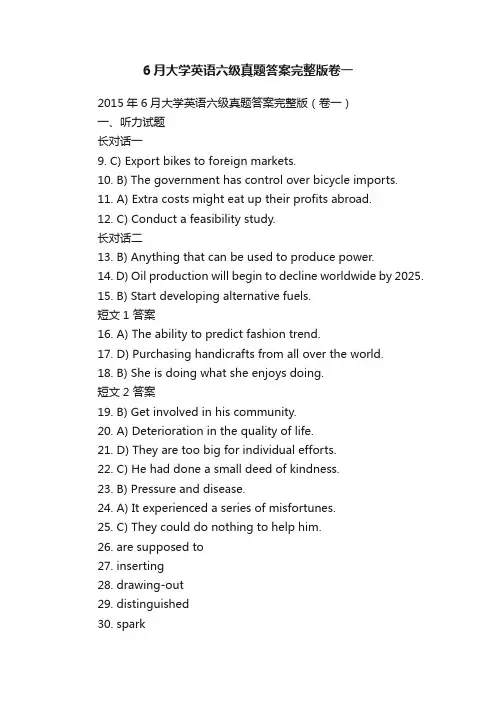
6月大学英语六级真题答案完整版卷一2015年6月大学英语六级真题答案完整版(卷一)一、听力试题长对话一9. C) Export bikes to foreign markets.10. B) The government has control over bicycle imports.11. A) Extra costs might eat up their profits abroad.12. C) Conduct a feasibility study.长对话二13. B) Anything that can be used to produce power.14. D) Oil production will begin to decline worldwide by 2025.15. B) Start developing alternative fuels.短文1 答案16. A) The ability to predict fashion trend.17. D) Purchasing handicrafts from all over the world.18. B) She is doing what she enjoys doing.短文2 答案19. B) Get involved in his community.20. A) Deterioration in the quality of life.21. D) They are too big for individual efforts.22. C) He had done a small deed of kindness.23. B) Pressure and disease.24. A) It experienced a series of misfortunes.25. C) They could do nothing to help him.26. are supposed to27. inserting28. drawing-out29. distinguished30. spark31. flame32. schooling33. controversies34. are concerned with35. dissatisfaction36 N swept37 B displaced38 I prosperity39 H productive40 C employed41 F jobless42 M shrunk43 A benefits44 E impact45 D eventually56 C) Unemployment57 D) Pour money into the market through asset buying.58 B) Deflation.59 C) Tighten financial regulation.60 C) She is one of the world’s greatest economists.(B和C 有争议)二、阅读试题36 N swept37 B displaced38 I prosperity39 H productive40 C employed41 F jobless42 M shrunk43 A benefits44 E impact45 D eventually56 C) Unemployment57 D) Pour money into the market through asset buying.58 B) Deflation.59 C) Tighten financial regulation.60 C) She is one of the world’s greatest economists.(B和C 有争议)三、翻译中国传统的待客之道要求饭菜丰富多样,客人吃不完,中国宴席上典型的菜单包括开席的一套凉菜及其后的热菜,例如肉类、鸡鸭、蔬菜等。
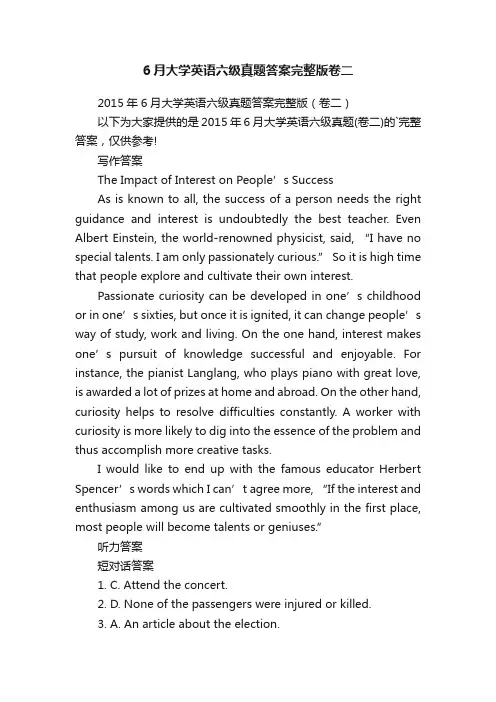
6月大学英语六级真题答案完整版卷二2015年6月大学英语六级真题答案完整版(卷二)以下为大家提供的是2015年6月大学英语六级真题(卷二)的`完整答案,仅供参考!写作答案The Impact of Interest on People’s SuccessAs is known to all, the success of a person needs the right guidance and interest is undoubtedly the best teacher. Even Albert Einstein, the world-renowned physicist, said, “I have no special talents. I am only passionately curious.” So it is high time that people explore and cultivate their own interest.Pa ssionate curiosity can be developed in one’s childhood or in one’s sixties, but once it is ignited, it can change people’s way of study, work and living. On the one hand, interest makes one’s pursuit of knowledge successful and enjoyable. For instance, the pianist Langlang, who plays piano with great love, is awarded a lot of prizes at home and abroad. On the other hand, curiosity helps to resolve difficulties constantly. A worker with curiosity is more likely to dig into the essence of the problem and thus accomplish more creative tasks.I would like to end up with the famous educator Herbert Spencer’s words which I can’t agree more, “If the interest and enthusiasm among us are cultivated smoothly in the first place, most people will become talents or geniu ses.”听力答案短对话答案1. C. Attend the concert.2. D. None of the passengers were injured or killed.3. A. An article about the election.4. A. The restaurant was not up to the speaker’s expectations.5. C. He has many things to deal with right now.6. D. More students have to appear to make their voice heard.7. B. The speakers like watching TV very much.8. D. The woman will be able to attend the classes she wants.长对话一9. C) Export bikes to foreign markets.10. B) The government has control over bicycle imports.11. A) Extra costs might eat up their profits abroad.12. C) Conduct a feasibility study.长对话二13. B) Anything that can be used to produce power.14. D) Oil production will begin to decline worldwide by 2025.15. B) Start developing alternative fuels.阅读答案选词填空答案36. J) philosophy37. I) mirrors38. B) constrained39. D) explore40. L) sneaking41. K) potential42. O) violent43. F) interacting44. A) assess45. N) undermines长篇阅读46. In theory, free competition is supposed to reduce the margin of profits to the minimum.C) Our current brand of capitalism is a fake capitalism…47. The United States is now characterized by a great division between the rich and the poor.A) A dangerous trend has developed over this past third of a century…48. America lacked the incentive to care for the majority of its citizens as it found no rival for its economic model.E) So why has America chosen these inequality-enhancing policies?...49. The wealthy top have come to take privileges for granted.I) Our division are deep…50. Many examples show the basic laws of imperial capitalism no longer apply in present-day America.B) Over the past year and a half, the Great Divide…51. The author suggests a return to the true spirit of the market.P) We need no just a new war on poverty but a war to protect the middle class…52. A quarter of the world’s prisoner population is in America.M) Where justice is concerned, there is also…53. Government regulation in America went from one extreme to the other in the past two decades.F) Ideology and interests combined viciously…54. Justice has become so expensive that only a small number of people like corporate executives can afford it.N) Justice has become a commodity, affordable to only a few…55. No country in the world so far has been able to provide completely equal opportunities for all.K) With almost a quarter of American children younger than 5 living…仔细阅读Passage One56 A) To get their share of clean air.57 C) Offering preferential treatment to wealthy countries.58 B) Our relationship to the plant world.59 D) By pooling their efforts together.60 C) Share life with nature.Passage Two。
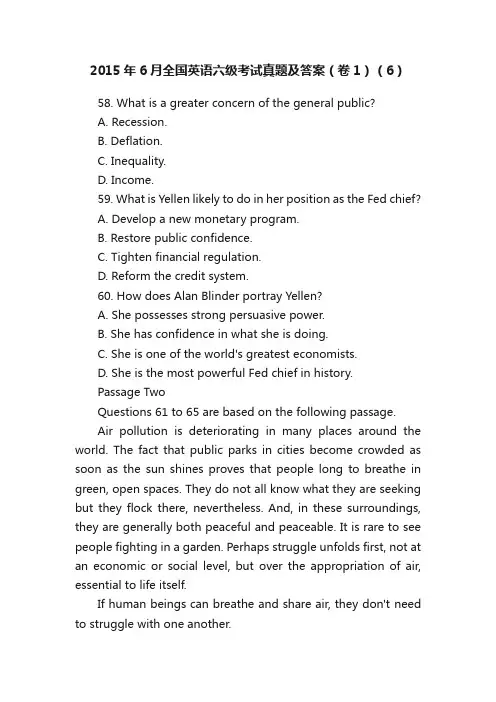
2015年6月全国英语六级考试真题及答案(卷1)(6)58. What is a greater concern of the general public?A. Recession.B. Deflation.C. Inequality.D. Income.59. What is Yellen likely to do in her position as the Fed chief?A. Develop a new monetary program.B. Restore public confidence.C. Tighten financial regulation.D. Reform the credit system.60. How does Alan Blinder portray Yellen?A. She possesses strong persuasive power.B. She has confidence in what she is doing.C. She is one of the world's greatest economists.D. She is the most powerful Fed chief in history.Passage TwoQuestions 61 to 65 are based on the following passage.Air pollution is deteriorating in many places around the world. The fact that public parks in cities become crowded as soon as the sun shines proves that people long to breathe in green, open spaces. They do not all know what they are seeking but they flock there, nevertheless. And, in these surroundings, they are generally both peaceful and peaceable. It is rare to see people fighting in a garden. Perhaps struggle unfolds first, not at an economic or social level, but over the appropriation of air, essential to life itself.If human beings can breathe and share air, they don't need to struggle with one another.Unfortunately, in our western tradition, neither materialist nor idealist theoreticians give enough consideration to this basic condition for life. As for politicians, despite proposing curbs on environmental pollution, they have not yet called for it to be made a crime. Wealthy countries are even allowed to pollute if they pay for it.But is our life worth anything other than money? The plant world shows us in silence what faithfulness to life consists of. It also helps us to a new beginning, urging us to care for our breath, not only at a vital but also at a spiritual level. The interdependence to which we must pay the closest attention is that whicl exists between ourselves and the plant world. Often described as "the lungs of the planet", the woods tha cover the earth offer us the gift of breathable air by releasing oxygen. But their capacity to renew the ai polluted by industry has long reached its limit. If we lack the air necessary for a healthy life, it is because we have filled it with chemicals and undercut the ability of plants to regenerate it. As we know, rapi deforestation combined with the massive burning of fossil fuels is an explosive recipe for an irreversibl disaster.The fight over the appropriation of resources will lead the entire planet to hell unless humans learn t share life, both with each other and with plants. This task is simultaneously ethical and political because can be discharged only when each takes it upon herself or himself and only when it is accomplishe together with others. The lesson taught by plants is that sharing life expands and enhances the sphere c the living, while dividing life into so-called natural or human resources diminishes it. We must come t view the air, the plants and ourselves as the contributors to the preservation of life and growth, rathe than a web of quantifiableobjects or productive potentialities at our disposal. Perhaps then we woulfinally begin to live, rather than being concerned with bare survival.注意:此部分试题请在答题卡2上作答。
2015年6月大学英语六级考试真题及答案Part IIListening ComprehensionSection ADirections:In this section, you will hear 8 short conversations and 2 long conversations. At theendofeachconversation,oneormorequestionswillbeaskedaboutwhatwassaid.Both econversation and the questions will be spoken only once. After each question there will be a pause.During the pause, you must read the four choices marked A), B), C) and D), and decide which isthe best answer. Then mark the corresponding letter on Answer Sheet 1 with a single line throughthe centre.注意:此部分试题请在答题卡1上作答。
1.A. Prepare for his exams.B. Catch up on his work.C. Attend the concert.D. Go on a vacation.2.A. Three crew members were involved in the incident.B. None of the hijackers carried any deadly weapons.C. The plane had been scheduled to fly to Japan.D. None of the passengers were injured or killed.3.A. An article about the election.B. A tedious job to be done.C. An election campaign.D. A fascinating topic.4.A. The restaurant was not up to the speakers' expectations.B. The restaurant places many ads in popular magazines.C. The critic thought highly of the Chinese restaurant.D. Chinatown has got the best restaurant in the city.5.A. He is going to visit his mother in the hospital.B. He is going to take on a new job next week.C. He has many things to deal with right now.D. He behaves in a way nobody understands.6.A. A large number of students refused to vote last night.B. At least twenty students are need to vote on an issue.C. Major campus issues had to be discussed at the meeting.D. More students have to appear to make their voice heard.7.A. The woman can hardly tell what she likes.B. The speakers like watching TV very much.(30 minutes)C. The speakers have nothing to do but watch TV.D. The man seldom watched TV before retirement.8.A. The woman should have retired earlier. 4B. He will help the woman solve the problem.C. He finds it hard to agree with what the woman says.D. The woman will be able to attend the classes she wants. Questions 9 to 12 are based on the conversation you have just heard.9.B. Employ the most up-to-date technology.C. Export bikes to foreign markets.D. Expand their domestic business.10.A. The state subsidizes small and medium enterprises.B. The government has control over bicycle imports.D. They have a cost advantage and can charge higher prices. ^11.A. Extra costs might eat up their profits abroad.B. More workers will be need to do packaging.C. They might lose to foreign bike manufacturers.D. It is very difficult to find suitable local agents.12.A. Report to the management.B. Attract foreign investments.C. Conduct a feasibility study.D. Consult financial experts.Questions 13 to 15 are based on the conversation you have just heard.13.B. Anything that can be used to produce power.C. Fuel refined from oil extracted from underground.D. Electricity that keeps all kinds of machines running.14.A. Oil will soon be replaced by alternative energy sources.B. Oil reserves in the world will be exhausted in a decade.C. Oil consumption has given rise to many global problems.D. Oil production will begin to decline worldwide by2015.15.A. Minimize the use of fossil fuels.B. Start developing alternative fuels.C. Find the real cause for global warming.D. Take steps to reduce the greenhouse effect.Section BDirections:In this section, you will hear 3 short passages. At the end of each passage, you willhear some questions. Both the passage and the questions will be spoken only once. After you heara question, you must choose the best answer from the four choices marked A), B), C) and D).Then mark the corresponding letter on Answer Sheet 1 with a single line through the centre.注意:此部分试题请在答题卡1上作答。
2015年6月英语六级考试真题试卷附答案和解析(第1套) 六级写作Directions: For this part, you are allowed 30 minutes to write an essay commenting on the saying"Knowledge is a treasure, but practice is the key to it. " You can give an example or two to illustrate your point of view. You should write at least 150 words but no more than 200 words.注意:此部分试题请在答题卡1上作答。
听力选择题Section ADirections: In this section, you will hear 8 short conversations and 2 long conversations. At the end of eachconversation, one or more questions will be asked about what was said. Both the conversation and the questions will be spoken only once. After each question there will be a pause. During the pause, you must read the four choices marked A., B., C. and D ), and decide which is the best answer. Then mark the corresponding letter on Answer Sheet 1 with a single line through the centre.注意:此部分试题请在答题卡1上作答。
2015大学英语六级真题答案完整版听力答案短对话答案1. C. Attend the concert.2. D. None of the passengers were injured or killed.3. A. An article about the election.4. A. The restaurant was not up to the speaker’s expectations.5. C. He has many things to deal with right now.6. D. More students have to appear to make their voice heard.7. B. The speakers like watching TV very much.8. D. The woman will be able to attend the classes she wants.长对话一9. C) Export bikes to foreign markets.10. B) The government has control over bicycle imports.11. A) Extra costs might eat up their profits abroad.12. C) Conduct a feasibility study.长对话二13. B) Anything that can be used to produce power.14. D) Oil production will begin to decline worldwide by 2025.15. B) Start developing alternative fuels.写作答案The Impact of Interest on People’s SuccessAs is known to all, the success of a person needs the right guidance and interest is undoubtedly the best teacher. Even Albert Einstein, the world-renowned physicist, said, “I have no special talents. I am only passionately curious.” So it is high time that people explore and cultivate their own interest.Passionate curiosity can be developed in one’s childhoodor in one’s sixties, but once it is ignited, it can change people’s way of study, work and living. On the one hand, interest makes one’s pursuit of knowledge successful and enjoyable. For instance, the pianist Langlang, who plays piano with great love, is awarded a lot of prizes at home and abroad. On the other hand, curiosity helps to resolve difficulties constantly. A worker with curiosity is more likely to dig into the essence of the problem and thus accomplish more creative tasks.I would like to end up with the famous educator Herbert Spencer’s words which I can’t agree more, “If the interest and enthusiasm among us are cultivated smoothly in the first place, most people will become talents or geniuses.”阅读答案选词填空答案36. J) philosophy37. I) mirrors38. B) constrained39. D) explore40. L) sneaking41. K) potential42. O) violent43. F) interacting44. A) assess45. N) undermines长篇阅读46. In theory, free competition is supposed to reduce the margin of profits to the minimum.C) Our current brand of capitalism is a fake c apitalism…47. The United States is now characterized by a great division between the rich and the poor.A) A dangerous trend has developed over this past third of a century…48. America lacked the incentive to care for the majority of its citizens as it found no rival for its economic model.E) So why has America chosen these inequality-enhancing policies?...49. The wealthy top have come to take privileges for granted.I) Our division are deep…50. Many examples show the basic laws of imperial capitalism no longer apply in present-day America.B) Over the past year and a half, the Great Divide…51. The author suggests a return to the true spirit of the market.P) We need no just a new war on poverty but a war to protect the middle class…52. A quarter of t he world’s prisoner population is in America.M) Where justice is concerned, there is also…53. Government regulation in America went from one extreme to the other in the past two decades.F) Ideology and interests combined viciously…54. Justice has become so expensive that only a small number of people like corporate executives can afford it.N) Justice has become a commodity, affordable to only a few…55. No country in the world so far has been able to provide completely equal opportunities for all.K) With almost a quarter of American children younger than 5 living…仔细阅读Passage One56 A) To get their share of clean air.57 C) Offering preferential treatment to wealthy countries.58 B) Our relationship to the plant world.59 D) By pooling their efforts together.60 C) Share life with nature.Passage Two61 B) Attend the school once they are admitted.62 A) To make sure they get qualified students.63 C) It allows them little time to make informed decisions.64 D) It places students from lower-income families at a disadvantage.65 B) Avoid choosing early decision unless they are fully prepared.翻译答案2011年是中国城市化(urbanization)进程中的历史性时刻,其城市人口首次超过农村人口。
2015年6月大学英语六级考试真题(第一套)Reading comprehension Section A Innovation, the elixir (灵丹妙药) of progress, has always cost people their jobs. In the Industrial Revolution hand weavers were ___36___ aside by the mechanical loom. Over the past 30 years the digital revolution has ___37___ many of the mid-skill jobs that underpinned 20th-century middle-class life. Typists, ticket agents, bank tellers and many production-line jobs have been dispensed with, just as the weavers were. For those who believe that technological progress has made the world a better place, such disruption is a natural part of rising ___38___. Although innovation kills some jobs, it creates new and better ones, as a more ___39___ society becomes richer and its wealthier inhabitants demand more goods and services. A hundred years ago one in three American workers was ___40___ on a farm. Today less than 2% of them produce far more food. The millions freed from the land were not rendered ___41___, but found better-paid work as the economy grew more sophisticated. Today the pool of secretaries has___42___, but there are ever more computer programmers and web designers. Optimism remains the right starting-point, but for workers the dislocating effects of technology may make themselves evident faster than its ___43___. Even if new jobs and wonderful products emerge, in the short term income gaps will widen, causing huge social dislocation and perhaps even changing politics. Technology's ___44___ will feel like a tornado (旋风), hitting the rich world first, but ___45___ sweeping through poorer countries too. No government is prepared for it.Section BWhy the Mona Lisa Stands Out[A] Have you ever fallen for a novel and been amazed not to find it on lists of great books? Or walked around a sculpture renowned as a classic, struggling to see what the fuss is about? If so, you‟ve probably pondered the question Cutting asked himself that day: how does a work of art come to be considered great?[B] The intuitive answer is that some works of art are just great: of intrinsically superior quality. The paintings that win prime spots in galleries, get taught in classes and reproduced in books are the ones that have proved their artistic value over time. If you can‟t see they‟re superior, that‟s your problem. It‟s an intimidatingly neat explanation. But some social scientists have been asking awkward questions of it, raising the possibility that artistic canons are little more than fossilised historical accidents.[C] Cutting, a professor at Cornell Univer sity, wondered if a psychological mechanism known as the “mere-exposure effect” played a role in deciding which paintings rise to the top of the cultural league. Cutting designed an experiment to test his hunch. Over a lecture course he regularly showed undergraduates works of impressionism for two seconds at a time. Some of the paintings were canonical, included in art-history books. Others were lesser known but of comparable quality. These were exposed four times as often. Afterwards, the students preferred them to the canonical works, while a control group of students liked the canonical ones best. Cutting‟s students had grown to like those paintings more simply because they had seen them more.[D] Cutting believes his experiment offers a clue as to how canons are formed. He points out that the most reproduced works of impressionism today tend to have been bought by five or six wealthy and influential collectors in the late 19th century. The preferences of these men bestowed prestige on certain works, which made the works more likely to be hung in galleries and printed in anthologies. The fame passed down the years, gaining momentum from mere exposure as it did so. The more people were exposed to, the more they liked it, and the more they liked it, the more it appeared in books, on posters and in big exhibitions. Meanwhile, academics and critics created sophisticated justifications for its pre-eminence. After all, it‟s not just the masses who tend to rate what they see more often more highly. As contemporary artists like Warhol and Damien Hirst have grasped, critical acclaim is deeply entwined with publicity. “Scholars”, Cutting argues, “are no different from the public in the effects of mere exposure.”[E] The process described by Cutting evokes a princi ple that the sociologist Duncan Watts calls “cumulative advantage”: once athing becomes popular, it will tend to become more popular still. A few years ago, Watts, who is employed by Microsoft to study the dynamics of social networks, had a similar experience to Cutting in another Paris museum. After queuing to see the “Mona Lisa” in its climate-controlled bulletproof box at the Louvre, he came away puzzled: why was it considered so superior to the three other Leonardos in the previous chamber, to which nobody seemed to be paying the slightest attention?[F] When Watts looked into the history of “the greatest painting of all time”, he discovered that, for most of its life, the “Mona Lisa” remained in relative obscurity. In the 1850s, Leonardo da Vinci was considered no match for giants of Renaissance art like Titian and Raphael, whose works were worth almost ten times as much as the “Mona Lisa”. It was only in the 20th century that Leonardo‟s portrait of his patron‟s wife rocketed to the number-one spot. W hat propelled it there wasn‟t a scholarly re-evaluation, but a theft.[G] In 1911 a maintenance worker at the Louvre walked out of the museum with the “Mona Lisa” hidden under his smock. Parisians were aghast at the theft of a painting to which, until then, they had paid little attention. When the museum reopened, people queued to see the gap where the “Mona Lisa” had once hung in a way they had never done for the painting itself. From then on, the “Mona Lisa” came to represent Western culture itself.[H] Although many have tried, it does seem improbable that the painting‟s unique status can be attributed entirely to the qua lity of its brushstrokes. It has been said that the subject‟s eyes follow the viewer around the room. But as the painting‟s biogra pher, Donald Sassoon, dryly notes, “In reality the effect can be obtained from any portrait.” Duncan Watts proposes that the “Mona Lisa” is merely an extreme example of a general rule. Paintings, poems and pop songs are buoyed or sunk by random events or preferences that turn into waves of influence, rippling down the generations.[I] “Saying that cultural objects have value,” Brian Eno once wrote, “is like saying that telephones have conversations.” Nea rly all the cultural objects we consume arrive wrapped in inherited opinion; our preferences are always, to some extent, someone else‟s. Visitors to the “Mona Lisa” know they are about to visit the greatest work of art ever and come away appropriately impressed—or let down. An audience at a performance of “Hamlet” know it is regarded as a work of genius, so that is what they mostly see. Watts even calls the pre-eminence of Shakespeare a “historical accident”.[J] Although the rigid high-low distinction fell apart in the 1960s, we still use culture as a badg e of identity. Today‟s fashion for eclecticism—“I love Bach, Abba and Jay Z”—is, Shamus Khan , a Columbia University psychologist, argues, a new way for the middle class to distinguish themselves from what they perceive to be the narrow tastes of those beneath them in the social hierarchy. [K] The intrinsic quality of a work of art is starting to seem like its least important attribute. But perhaps it‟s more significant than our social scientists allow. First of all, a work needs a certain quality to be eligible to be swept to the top of the pile. The “Mona Lisa” may not be a worthy world champion, but it was in the Louvre in the first place, and not by accident. Secondly, some stuff is simply better than other stuff. Read “Hamlet” after reading even the gr eatest of Shakespeare‟scontemporaries, and the difference may strike you as unarguable.[L] A study in the British Journal of Aesthetics suggests that the exposure effect doesn‟t work the same way on everything, a nd points to a different conclusion about how canons are formed. The social scientists are right to say that we should be a little skeptical of greatness, and that we should always look in the next room. Great art and mediocrity can get confused, even by experts. But that‟s why we need to see, and read, as much as we can. The more we‟re exposed to the good and the bad, the better we are at telling the difference. The eclecticists have it.46. According to Duncan Watts, the superiority of the "Mona Lisa" to Leonardo's other works resulted from the cumulative advantage.47. Some social scientists have raised doubts about the intrinsic value of certain works of art.48. It is often random events or preferences that determine the fate of a piece of art.49. In his experiment, Cutting found that his subjects liked lesser known works better than canonical works because of more exposure.50. The author thinks the greatness of an art work still lies in its intrinsic value.51. It is true of critics as well as ordinary people that the popularity of artistic works is closely associated with publicity.52. We need to expose ourselves to more art and literature in order to tell the superior from the inferior.53. A study of the history of the greatest paintings suggests even a great work of art could experience years of neglect.54. Culture is still used as a mark to distinguish one social class from another.55. Opinions about and preferences for cultural objects are often inheritable.Section C Passage OneWhen the right person is holding the right job at the right moment, that person's influence is greatly expanded. That is the position in which Janet Yellen, who is expected to be confirmed as the next chair of the Federal Reserve Bank (Fed) in January, now finds herself. If you believe, as many do, that unemployment is the major economic and social concern of our day, then it is no stretch to think Yellen is the most powerful person in the world right now.Throughout the 2008 financial crisis and the recession and recovery that followed, central banks have taken on the role of stimulators of last resort, holding up the global economy with vast amounts of money in the form of asset buying. Yellen, previously a Fed vice chair, was one of the principal architects of the Fed's $3.8 trillion money dump. A star economist known for her groundbreaking work on labor markets, Yeilen was a kind of prophetess early on in the crisis for her warnings about the subprime(次级债)meltdown. Now it will be her job to get the Fed and the markets out of the biggest and most unconventional monetary program in history without derailing the fragile recovery.The good news is that Yellen, 67, is particularly well suited to meet these challenges. She has a keen understanding of financial markets, an appreciation for their imperfections and a strong belief that human suffering was more related to unemployment than anything else.Some experts worry that Yellen will be inclined to chase unemployment to the neglect of inflation. But with wages still relatively flat and the economy increasingly divided between the well-off and the long-term unemployed' more people worry about the opposite, deflation(通货紧缩)that would aggravate the economy's problems.Either way, the incoming Fed chief will have to walk a fine line in slowly ending the stimulus. It must be steady enough to deflate bubbles(去泡沫)and bring markets back down to earth but not so quick that it creates another credit crisis.Unlike many past Fed leaders, Yellen is not one to buy into the finance industry's argument that it should be left alone to regulate itself. She knows all along the Fed has been too slack on regulation of finance.Yellen is likely to address right after she pushes unemployment below 6%, stabilizes markets and makes sure that the recovery is more inclusive and robust. As Princeton Professor Alan Blinder says' "She's smart as a whip, deeply logical, willing to argue but also a good listener. She can persuade without creating hostility." AH those traits will be useful as the global economy's new power player takes on its most annoying problems.56. What do many people think is the biggest problem facing Janet Yellen?A) Lack of money. B) Subprime crisis. C) Unemployment. D) Social instability.57. What did Yellen help the Fed do to tackle the 2008 financial crisis?A) Take effective measures to curb inflation. B) Deflate the bubbles in the American economy.C) Formulate policies to help financial institutions.D) Pour money into the market through asset buying.58. What is a greater concern of the general public?A) Recession. B) Deflation. C) Inequality. D) Income.59. What is Yellen likely to do in her position as the Fed chief?A) Develop a new monetary program. B) Restore public confidence.C) Tighten financial regulation. D) Reform the credit system.60. How does Alan Blinder portray Yellen?A) She possesses strong persuasive power. B) She has confidence in what she is doing.C) She is one of the world's greatest economists. D) She is the most powerful Fed chief in history.Passage TwoAir pollution is deteriorating in many places around the world. The fact that public parks in cities become crowded as soon as the sun shines proves that people long to breathe in green, open spaces. They do not all know what they are seeking but they flock there, nevertheless. And, in these surroundings, they are generally both peaceful and peaceable. It is rare to see people fighting in a garden. Perhaps struggle unfolds first, not at an economic or social level, but over the appropriation of air, essential to life itself. If human beings can breathe and share air, they don't need to struggle with one another.Unfortunately, in our western tradition, neither materialist nor idealist theoreticians give enough consideration to this basiccondition for life. As for politicians, despite proposing curbs on environmental pollution, they have not yet called for it to be made a crime. Wealthy countries are even allowed to pollute if they pay for it.But is our life worth anything other than money? The plant world shows us in silence what faithfulness to life consists of. It also helps us to a new beginning, urging us to care for our breath, not only at a vital but also at a spiritual level. The interdependence to which we must pay the closest attention is that which exists between ourselves and the plant world. Often described as "the lungs of the planet", the woods that cover the earth offer us the gift of breathable air by releasing oxygen. But their capacity to renew the air polluted by industry has long reached its limit. If we lack the air necessary for a healthy life, it is because we have filled it with chemicals and undercut the ability of plants to regenerate it. As we know, rapid deforestation combined with the massive burning of fossil fuels is an explosive recipe for an irreversible disaster.The fight over the appropriation of resources will lead the entire planet to hell unless humans learn to share life, both with each other and with plants. This task is simultaneously ethical and political because it can be discharged only when each takes it upon herself or himself and only when it is accomplished together with others. The lesson taught by plants is that sharing life expands and enhances the sphere of the living, while dividing life into so-called natural or human resources diminishes it. We must come to view the air, the plants and ourselves as the contributors to the preservation of life and growth, rather than a web of quantifiable objects or productive potentialities at our disposal. Perhaps then we would finally begin to live, rather than being concerned with bare survival.61. What does the author assume might be the primary reason that people would struggle with each other?A) To get their share of clean air. B) To pursue a comfortable life.C) To gain a higher social status. D) To seek economic benefits.62. What does the author accuse western politicians of?A) Depriving common people of the right to clean air.B) Giving priority to theory rather than practical action.C) Offering preferential treatment to wealthy countries.D) Failing to pass laws to curb environmental pollution.63. What does the author try to draw our closest attention to?A) The massive burning of fossil fuels. B) Our relationship to the plant world.C) The capacity of plants to renew polluted air. D) Large-scale deforestation across the world. 64. How can human beings accomplish the goal of protecting the planet according to the author?A) By showing respect for plants. B) By preserving all forms of life.C) By tapping all natural resources. D) By pooling their efforts together.65. What does the author suggest we do in order not just to survive?A) Expand the sphere of living. B) Develop nature's potentials.C) Share life with nature. D) Allocate the resources.Part IV Translation (30 minutes)中国传统的待客之道要求饭菜丰富多样,让客人吃不完。